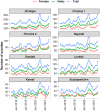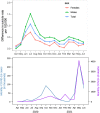Association between COVID-19 pandemic and the suicide rates in Nepal
- PMID: 35073377
- PMCID: PMC8786170
- DOI: 10.1371/journal.pone.0262958
Association between COVID-19 pandemic and the suicide rates in Nepal
Abstract
Background: Past works have linked the COVID-19 pandemic and subsequent public health responses such as isolation, quarantine, and lockdown to increased anxiety, sleep disorders, depressive symptoms, and suicidal ideation. Only a few studies, mostly carried out in high-income countries, have investigated the association between the pandemic and suicide rate. We seek to investigate the changes in the monthly suicide rates during the COVID-19 pandemic in Nepal, compared to the pre-pandemic suicide rates.
Methods and findings: This is a retrospective study investigating the changes in suicide rates in Nepal during the COVID-19 pandemic period (April 2020 to June 2021), compared to the pre-pandemic period (July 2017 to March 2020), adjusted for seasonality and long-term trend in the suicide rate. We performed analysis for the entire country as well as sub-sample analyses stratified by gender and provinces. A total of 24350 suicides deaths during four years of the study window were analyzed. We found an overall increase in the monthly suicide rate in Nepal with an average increase of 0.28 (CI: 0.12,0.45) suicide per 100,000 during the pandemic months. The increase in suicide rate was significant both among males (increase in rate = 0.26, CI: 0.02,0.50) and females (increase in rate = 0.30, CI: 0.18,0.43). The most striking increments in suicide rates were observed in June, July, and August 2020. The pattern of increased suicide rates faded away early on among males, but the effect was sustained for a longer duration among females. Sudurpaschim and Karnali provinces had the highest increase in suicide rates associated with the COVID-19 pandemic.
Conclusions: The COVID-19 pandemic is associated with an increased suicide rate in Nepal. The findings may inform policymakers in designing appropriate public health responses to the pandemic that are considerate of the potential impact on mental health and suicide.
Conflict of interest statement
The authors have declared that no competing interests exist.
Figures


Comment in
-
Suicide situation in Nepal: Is intervention needed?Int J Surg. 2022 Oct;106:106912. doi: 10.1016/j.ijsu.2022.106912. Epub 2022 Sep 13. Int J Surg. 2022. PMID: 36113841 No abstract available.
References
-
- World Health Organization. Mental health and psychosocial considerations during the COVID-19 outbreak, 18 March 2020. World Health Organization; 2020.
-
- Reger MA, Stanley IH, Joiner TE. Suicide mortality and coronavirus disease 2019—a perfect storm? JAMA psychiatry. 2020;77(11):1093–1094. - PubMed
MeSH terms
LinkOut - more resources
Full Text Sources
Medical
Miscellaneous

